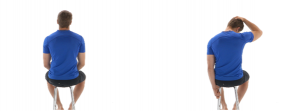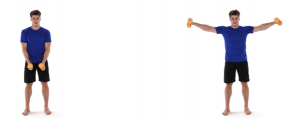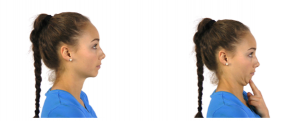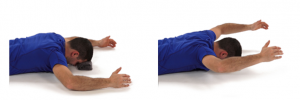Introduction
The Neck and shoulder group aims to help you recover from aches and pains or surgery in the neck or shoulder and to show you how to get your joint movement, muscle power and flexibility back. We want to support you to achieve your goals and return to your normal levels of activity. Having looked at the difficulties and / or pain you are experiencing, we are offering you this as the best and quickest way to make a full recovery.
What to expect
This is a physical, progressive exercise rehabilitation group. The group usually consists of up to 12 people, who are at varying stages of recovery for a variety of problems. The therapist will confirm some details with you at the start of the class and provide you with information on what to expect. You will be monitored and guided through the exercises and with time you will become familiar and more confident. We would like you to attend 4 regular sessions and it is important to practice these exercises at home in between sessions and once your treatment has finished.
What will I need?
- Wear loose fitting clothing that is comfortable to move in
- Wear supportive footwear such as trainers
- You may wish to bring a drink
Read our FAQs for more information about our classes and what to expect.
Self-help exercises
Try to find 5-10 minutes in your daily routine to complete some of these exercises, choosing 3-4 different ones each time to practice.
To make progress with your recovery, each exercise should be easy and comfortable at the start but slightly uncomfortable by the end, with the discomfort easing within 10 minutes of finishing.
If it is too hard (very uncomfortable or doesn’t ease off) do less repetitions or the easier version next time. If it is too easy (doesn’t get uncomfortable by the end) do more repetitions or the harder version of the exercise next time. The exercises provided are a guide and not all of them may be appropriate for you. Speak to your therapist for specific guidance on your home program or if you have any concerns with any of the exercises.
Exercise 1

Stand with feet slightly apart; you can stand against a wall if you find it easier. Stand tall with arms out to the sides and elbows bent so that forearms point forwards and thumbs point up.
Rotate your arms so your thumbs are pointing backward (or touch the wall).
Squeeze between the lower shoulder blades so the shoulders stay down throughout the movement.
Slowly go back to the starting position and repeat.
+ To make this harder hold a small weight (use a tin of soup or small drinks bottle if at home) in each hand.
– To make it easier bring the elbows down so they are halfway to your sides. Thumbs should still be pointing upwards.
Exercise 2

Sit in a chair. Tilt your head to one side while tucking in your chin and flexing the neck as if to look at your toes.
Maintain the stretch and relax. Repeat to the opposite side.
+ To make it harder, before you move your head grasp the seat with your affected hand to lower your shoulder. You could also place your other hand on your head and pull it down until a stretch is felt on top of the shoulder.
– To make it easier just do gentle movements from side to side with your head without taking it into a full stretch.

Stand upright with your arms down by your sides with one small weight in each hand.
Lift your arms up on the side, not higher than shoulder height.
Keep the elbows slightly bent.
Lower and repeat. At home, food tins or small drinks bottles can be used as weights.
+ To make this harder use a heavier weight
– To make this easier use a lighter weight or no weight at all
Exercise 4

Stand with your feet together and bend over to touch the floor with your hands (the knees can flex slightly).
‘Walk’ your hands forward one by one without moving the feet.
Walk your hands out as far as possible holding your tummy muscles so that your bottom stays up. Walk your hands back to the starting position and repeat.
+ To make this harder go all the way out to a press up position and bend and stretch your elbows to incorporate a press up.
– To make this easier start in a kneeling position.
Exercise 5

Support yourself on a bench, bed or chair(s) as shown.
Squeeze the shoulder blade and pull the weight toward the side of your body, next to your tummy.
Try to make the muscles of your shoulder blade pull the arm up, aiming your elbow out behind you.
Keep your hips stable and in one place so that only your arm is moving. Use a food tin or small drink bottle as a weight at home.
+ To make this harder increase the heaviness of the weight (use a few tins of food in a carrier bag at home)
– To make this easier try a lighter weight or no weight at all to get started
Exercise 6

Start in an ‘all fours’ position, with knees and hands on the floor.
Keep your chin in, back straight and shoulders back.
With one arm reach under the other as far as possible rotating and rounding your upper back.
Bring your arm back and reach back in the opposite direction as far as possible.
Keep your elbow bent to 90 degrees and look at your moving hand at all times.
Repeat with the other arm.
+ To make this harder hold a weight in the moving hand.
– To make this easier do it in a sitting position; starting with arms out in front of you then passing one under the other to reach around your body, twisting your neck and upper back at the same. One arm should stay relatively still.
Exercise 7

Stand or sit tall.
Focus on something at eye level while you slowly move your head back over your body and tuck your chin in. You may find it helpful to guide the movement with your hand on your chin.
Return to initial position and repeat.
+ To make this harder do it against the wall, eventually pushing the back of your head against the wall.
– To make this easier just gently move your head backwards and forwards but without tilting your chin or changing the level of your gaze
Exercise 8

Lie on your stomach, face down with your arms overhead, elbows bent and thumbs pointing upward.
Lift your elbows and hands off the surface while pulling your shoulder blades together and downward.
Let your elbows down and repeat.
+ To make this harder hold a small weight in each hand.
– To make this easier lift your elbows first and then your hands
Physical activity reduces the chances of major illness
The importance of being active
NHS guidleines recommend the following:
- 150mins moderate intensity exercise a week
- 30mins x 5 = Weekly recommended activity
- Moderate intensity = any exercise that elevates the heart/ breathing rate to a point where you can still hold a conversation 75mins of intense exercise a week
- 15mins x 5 = Weekly recommended activity
- Intense exercise = any exercise that elevates heart rate
Physical benefits include
- Energy levels increased
- Increased physical strength
- Completing longer walks
- Grants you some more ability to do more things that you may enjoy Decreases chance of developing OA by 83%
Mental benefits include
- Stimulates Release of dopamine and serotonin
- Improving mood
- Reduces Stress
- Improves sleep – Serotonin has been shown to be assistive with sleep regulation
- Better digestion – Lower Serotonin presence in the gut is found to correlate with constipation
- Health is a state of complete physical, mental and social well-being and not merely the absence of disease or infirmity”. WHO
Vita is an award-winning, CQC registered healthcare provider














